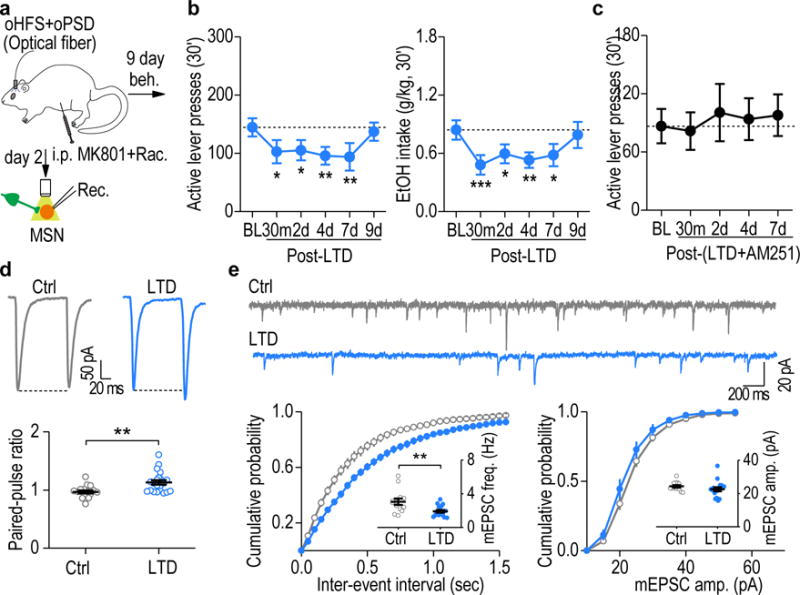Figure 4.

In vivo LTD induction caused a long-lasting reduction of alcohol-seeking behavior in an eCB-dependent manner. (a) Schematic of the in vivo LTD-inducing protocol (oHFS+oPSD+MK801+raclopride) and ex vivo LTD measurement. MK801 (0.1 mg/kg) and raclopride (0.01 mg/kg) were systemically administered 15 min before the optogenetic stimulation. (b) Delivery of the in vivo LTD-inducing protocol in the DMS produced a long-lasting decrease in active lever presses (left, F(5,38) = 3.89, P = 0.006) and alcohol intake (right, F(5,35) = 5.17, P = 0.0012). *P < 0.05, **P < 0.01, ***P < 0.001 vs. baseline (BL); n = 9 rats. (c) Delivery of the in vivo LTD-inducing protocol in the presence of AM251 failed to alter active lever presses. F(4,31) = 0.40, P = 0.81; n = 9 rats. (d,e) Delivery of the in vivo LTD-inducing protocol produced a long-lasting depression of glutamatergic transmission in the DMS on day 2 post-stimulation. (d) Top, sample traces showing paired-pulse ratios (100-ms inter-stimulus interval) measured in fluorescent neurons from LTD-induced rats and their controls (without light stimulation). Bottom, averaged data showing an increased paired-pulse ratio after LTD induction. t(36) = −3.31, P = 0.0021; n = 17 neurons, 3 rats (Ctrl) and 21 neurons, 5 rats (LTD). (e) Top, representative traces of mEPSCs in fluorescent neurons in LTD-induced and control rats. Bottom, cumulative distributions of inter-event intervals and amplitudes of mEPSCs. Inset, reduced frequency (left), but not amplitude (right), of mEPSCs after in vivo LTD induction. t(28) = 2.97, P = 0.006 for frequency; t(28) = 1.11, P = 0.28 for amplitude; n = 13 neurons, 3 rats (Ctrl) and 17 neurons, 3 rats (LTD). One-way RM ANOVA for b, c; Two-sided unpaired t test for d, e. Data are presented as mean ± s.e.m.
